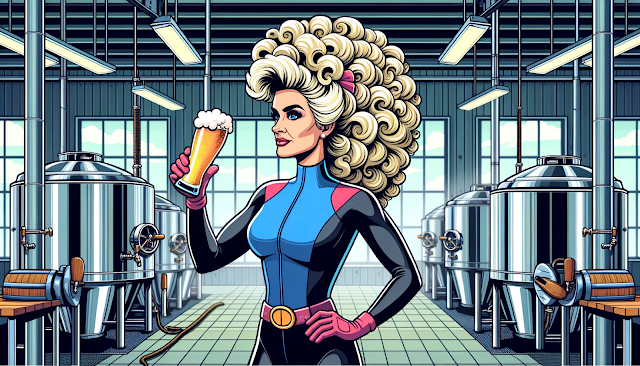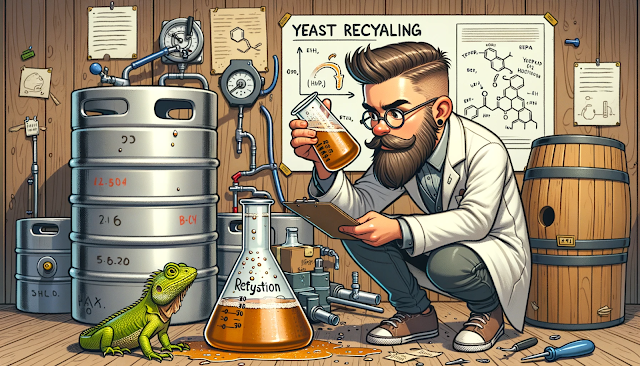The Brewer's Guide to Cold Crashing: Science, Steps, and Secrets
Cold crashing has become a staple in the toolkit of experienced homebrewers, and for good reason.
It’s a simple, effective method that elevates your beer’s clarity and smoothness, ensuring that what’s in your glass is as clean and refined as possible.
Whether you’re brewing a crisp lager or a hazy IPA, cold crashing can be the finishing touch that takes your homebrew to the next level.
Why Cold Crashing Matters: The Science of Clarity 🍺
Cold crashing is more than just a way to make your beer look better; it’s about improving flavor and mouthfeel.
By dropping the temperature post-fermentation, you leverage scientific principles to clarify your brew.
The process encourages unwanted yeast, hop particles, proteins, and other suspended matter to drop out of suspension and settle at the bottom of the fermenter.
This phenomenon is governed by Stokes' Law, which dictates how quickly a particle falls through a liquid.
The key takeaway is that larger, denser particles fall much faster.
Cooling the beer causes yeast cells to cease activity and clump together in a process called flocculation.
These larger clumps, along with hop matter, settle significantly faster than individual particles would.
Furthermore, cold crashing is the best weapon against chill haze.
This is a temporary cloudiness that appears when beer is cooled for serving, caused by proteins and polyphenols forming weak bonds.
By crashing the temperature before packaging, you force these bonds to form and precipitate out early, resulting in a beer that remains brilliantly clear even when ice-cold.
This results in a beer that’s not only clearer but also smoother, with fewer harsh or yeasty flavours.
Essential Gear for a Successful Cold Crash 🍻
To cold crash your beer properly, you’ll need a few key pieces of equipment:
- A Sealed Fermentation Vessel: Your fermenter must be able to be sealed airtight to prevent oxygen contamination.
- Temperature Control: A refrigerator or chest freezer with an external temperature controller is essential.
The goal is to maintain a stable, cold temperature just above freezing without turning your beer into an ice block.
- Thermometer: An accurate digital thermometer or a temperature strip on your fermenter is crucial for monitoring the process.
- Sanitization Tools: As always in brewing, cleanliness is paramount.
Ensure you have sanitizer ready for any equipment that might contact your beer.
Properly sanitized gear is your best defense against infection.
The Cold Crashing Process: A Step-by-Step Guide
With your gear ready, here is how to execute the perfect cold crash:
1. Ensure Fermentation Is Complete: Cold crashing before fermentation is finished can cause yeast to go dormant prematurely, leaving you with a sweet, under-attenuated beer.
Use a hydrometer to confirm your specific gravity has been stable for at least two consecutive days.
2. Set the Temperature: Dial in your temperature controller to a range between 0-4°C (32-40°F).
Lagers and crisp pilsners benefit from the colder end of this spectrum, while some ales can be crashed slightly warmer.
Avoid freezing your beer, which can cause damage to the vessel and affect flavour.
3. Set the Duration: Most beers will achieve excellent clarity within 24 to 48 hours.
For beers with a high sediment load, like heavily dry-hopped IPAs or dark stouts, you may need to extend this period to 72 hours to allow everything to settle fully.
4. Monitor the Process: Keep an eye on your temperature to ensure it remains stable.
Logging your process will help you replicate your successes and refine your technique for future batches.
Troubleshooting Common Cold Crashing Issues 🧐
Even a simple process can have challenges.
Here’s how to handle them:
- Oxygen Suck-Back: This is the biggest risk.
As the gas in your fermenter's headspace cools, its pressure drops (according to the Ideal Gas Law), creating a vacuum.
This can suck the liquid from your airlock (and dreaded oxygen) back into your beer.
Trick: To prevent this, you can replace your airlock with a sanitized solid bung once fermentation is confirmed complete, or even better, attach a CO₂ tank with a regulator set to 1-2 PSI to maintain positive pressure.
We do appreciate this is likely a step too far for simple home beer kit brewers!
- Sediment Won’t Drop: If clarity is still an issue, it’s time for fining agents.
Adding gelatin or Biofine during the cold crash will bind to particles and accelerate settling.
- Over-Carbonation in Bottles: This is usually caused by bottling before fermentation is truly finished.
If you are certain fermentation was complete, you may need to slightly adjust your priming sugar calculations for the colder, denser beer.
Post-Crash Protocol: Packaging and Conditioning 🍾
Once the crash is complete, handle your beer with care.
The primary goal is a gentle, oxygen-free transfer to bottles or a keg.
Use an auto-siphon and position it carefully above the yeast cake to avoid stirring up the sediment you just worked so hard to settle.
Next comes conditioning, where the beer matures and develops its final character.
Lighter styles like lagers may need several weeks of cold conditioning (lagering) to become perfectly smooth.
Heavier styles like stouts can also benefit from extended conditioning time to mellow out complex flavours.
Finally, store your bottles upright.
This ensures any remaining sediment settles at the bottom, allowing you to pour a clean, clear glass.
Always keep your beer in a cool, dark place to prevent light exposure, which can cause "skunking," a common off-flavour from a photochemical reaction.
Skunking is a fault you want to avoid at all costs.
Advanced Techniques and Best Practices ✨
To achieve ultimate clarity, fining agents are a game-changer.
Agents like gelatin or Biofine Clear are electrostatically charged and act like magnets, binding to yeast, proteins, and hop haze, and dragging them to the bottom of the fermenter.
Remember that not all beers require the same treatment.
For a hazy IPA, a hard cold crash can strip away the desirable haze that contributes to its flavour and mouthfeel.
For these styles, consider a "soft crash" to a warmer temperature (e.g., 10°C / 50°F) to settle out only the heaviest yeast without sacrificing the haze.
In contrast, for a pilsner or lager where brilliant clarity is paramount, a full, cold crash is essential.
Cold Crashing vs. Other Clarification Methods 🍻
Cold crashing is a powerful and low-cost tool for achieving brilliant clarity, but it's essential to understand its place within the broader spectrum of clarification techniques.
The right choice depends on your specific goals, the beer style you're brewing, your budget, and your timeline.
Let's take a deeper dive into how cold crashing compares to the other primary methods.
Filtration
Mechanism: Filtration is a purely mechanical process.
Beer is forced through a porous filter medium with a specific micron rating, physically stripping out suspended particles like yeast, proteins, and hop particulates.
A 5-micron filter will remove most yeast, while a 1-micron filter provides a brilliant "polish."
Pros:
- Speed: Filtration is almost instantaneous.
It can take a beer from cloudy to crystal clear in the time it takes to transfer it from one keg to another, whereas cold crashing requires 1-3 days. - Absolute Clarity: It can achieve a commercial-level, polished brilliance that is difficult to replicate with gravity-based methods alone.
Cons:
- Cost and Complexity: This is a major barrier for most homebrewers.
It requires dedicated equipment like filter housings, single-use cartridges, tubing, and often a pump, which represents a significant investment.
- Flavor and Aroma Stripping: This is the most significant drawback.
Fine filtration is indiscriminate; it can strip out desirable hop oils (aroma), proteins that contribute to a full mouthfeel and stable head retention, and even some color compounds.
Cold crashing is far more gentle, primarily targeting the largest and least stable particles.
- High Risk of Oxidation: Pushing beer through a filter system creates a massive opportunity for oxygen exposure, which can ruin a beer's flavour and long-term stability.
Mitigating this requires a sophisticated setup with the ability to completely purge the entire system with CO₂.
Verdict: While highly effective, filtration is generally overkill for most homebrewers.
It's best suited for those dedicated to brewing perfectly brilliant American Light Lagers or other styles where absolute clarity is paramount and who have the kegging equipment and expertise to manage the high risk of oxidation.
Extended Conditioning (Lagering & Aging)
Mechanism: This method relies on time and gravity.
By holding a beer at cold temperatures (typically 0-4°C or 32-40°F) for several weeks or months, particles like yeast and proteins are given a very long time to settle naturally.
This is essentially a very slow, prolonged cold crash.
Pros:
- Flavour Maturation: The primary benefit of lagering is not just clarity, but flavour development.
Over this extended period, yeast continues to work, cleaning up fermentation byproducts like diacetyl (buttery) and acetaldehyde (green apple), resulting in an exceptionally smooth, clean, and integrated flavour profile that a quick cold crash cannot produce.
- Simplicity: No extra steps are required beyond maintaining a stable cold temperature and being patient.
Cons:
- Time: This is the biggest trade-off.
A cold crash achieves remarkable clarity in days; true lagering takes weeks or months.
- Ties Up Equipment: Your beer will occupy a fermenter and valuable space in your temperature-controlled chamber for a very long time, limiting your brewing pipeline.
Verdict: Extended conditioning is a process, not just a technique.
It's essential for traditional lager styles where flavour maturation is just as important as clarity.
For these beers, a cold crash is simply one of the final steps within the longer lagering process.
Clarifying Agents (Finings)
Mechanism: Finings are additives that work through electrostatic charge, binding with suspended particles to create larger clumps (floccules) that settle out much faster.
They are best thought of as a booster for gravity-based clarification.
- Kettle Finings (e.g., Irish Moss, Whirlfloc): Added during the last 10-15 minutes of the boil.
These negatively charged carrageenan products bind with positively charged proteins in the hot wort, creating a better "hot break."
This removes potential haze-formers before fermentation even begins.
- Post-Fermentation Finings: These are added after fermentation is complete, often in conjunction with cold crashing.
This includes agents like Gelatin & Isinglass, which are positively charged and bind with yeast, and Silica-Based finings that excel at removing protein haze.
Pros:
- Synergy with Cold Crashing: Fining agents are not an alternative to cold crashing; they are an enhancement.
By creating larger, heavier particles, they dramatically accelerate the sedimentation process as described by Stokes' Law, making your cold crash faster and more effective.
- Targeted Action: You can choose an agent that specifically targets what is making your beer hazy, whether it's yeast or protein.
Cons:
- Dietary/Allergen Concerns: Many popular finings are animal-derived (gelatin, isinglass from fish, chitosan from shellfish), making them unsuitable for vegan beers.
- Potential for Stripping: While far more gentle than filtration, overuse of some finings can potentially reduce some desirable mouthfeel and head-retention compounds.
Verdict: Using fining agents is one of the best ways to elevate your clarification game.
Combining a kettle fining during the boil with a post-fermentation agent like gelatin during the cold crash is a powerful, synergistic approach that yields exceptionally clear beer without the cost and risks of filtration.






